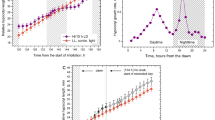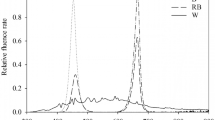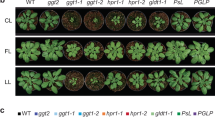Abstract
Stem and leaf tissues of Stellaria longipes Goldie (prairie ecotype) exhibit circadian rhythmicity in the activity and mRNA abundance for 1-aminocyclopropane-1-carboxylic acid oxidase (EC 1.4.3). The steady-state mRNA levels and enzymatic activity levels fluctuated with a period of approximately 24 h and reached their maxima by the middle of the light phase and minima by the middle of the dark phase. The oscillations showed damping under constant light, constant dark and constant temperature conditions, indicating that the rhythm is entrained by an external signal. The results indicate that light/dark cycles have greater entraining effects than temperature cycles. A 15-min red light pulse, but not a blue light pulse, could reset rhythm in continuous darkness, suggesting the possible role of a red-light signal transduction pathway in the circadian regulation of 1-aminocyclopropane-1-carboxylic acid oxidase.
Similar content being viewed by others
Abbreviations
- ACC:
-
1-aminocyclopropane-1-carboxylic acid
- DD:
-
continuous dark
- LD:
-
light-dark
- LL:
-
continuous light
- ZT:
-
Zeitgeber time (start of light period for circadian entrainment)
References
Abeles FB, Morgan PW, Saltveit Jr. ME (1992) Ethylene in plant biology. 2nd edn. Academic Press, New York, pp 147–154
Adams DO, Yang SF (1979) Ethylene biosynthesis: Identification of 1-aminocyclopropane-1-carboxylic acid as an intermediate in the conversion of methionine to ethylene. Proc Natl Acad Sci USA 76: 170–174
Bunning E (1973) The physiological clock. 3rd edn. Springer-Verlag, New York, USA
Chinnappa CC, Morton JK (1984) Studies on the Stellaria longipes complex (Caryophyllaceae) — biosystematics. Syst Bot 9: 60–73
Cohen AS, Cumming BG (1974) Endogenous rhythmic activity of nitrate reductase in a selection of Chenopodium rubrum. Can J Bot 52: 2351–2360
de Laat AMM, Brandenburg DCC, van Loon LC (1981) The modulation of the conversion of 1-aminocyclopropane-1-carboxylic acid to ethylene by light. Planta 153: 193–200
El-Beltagy AS, Kapuya JA, Madkour MA, Hall MA (1976) A possible endogenous rhythm in internal ethylene levels in leaves of Lycopersicon esculentum Mill. Plant Sci Lett 6: 175–180
Emery RJN (1995) Morphological and physiological phenotypic plasticity in alpine and prairie ecotypes of Stellaria longipes. Ph.D. thesis. The University of Calgary, Canada
Emery RJN, Reid DM, Chinnappa CC (1994a) Phenotypic plasticity of stem elongation in two ecotypes of Stellaria longipes: the role of ethylene and response to wind. Plant Cell Environment 17: 691–700
Emery RJN, Chinnappa CC, Chmielewski JG (1994b) Specialization, plant strategies, and phenotypic plasticity in populations of Stellaria longipes along an elevational gradient. Int J Plant Sci 155: 203–219
Feinberg AP, Vogelstein B (1983) A technique for radiolabeling DNA restriction endonuclease fragments to high specific activity. Anal Biochem 132: 6–13
Foster KR, Morgan PW (1995) Genetic regulation of development in Sorghum bicolor. IX. The ma R3 allele disrupts diurnal control of gibberellin biosynthesis. Plant Physiol 108: 337–343
Gepstein S, Thimann KV (1980) The effect of light on the production of ethylene from 1-aminocyclopropane-1-carboxylic acid by leaves. Planta 149: 196–199
Giuliano G, Hoffman NE, Ko K, Scolnik PA, Cashmore AR (1988) Light-entrained circadian clock controls transcription of several plant genes. EMBO J 7: 3635–3642
Henson IE, Alagarswamy G, Mahalakshmi V, Bidinger FV (1982) Diurnal changes in endogenous abscisic acid in leaves of pearl millet (Pennisetum americanum (L.) Leeke) under field conditions. J Exp Bot 33: 416–425
Hewett EW, Wareing PF (1973) Cytokinins in Populus x robusta (Schneid): light effects on endogenous levels. Planta 114: 119–129
Huse WD, Hansen C (1988) cDNA cloning redefined. A rapid, efficient, directional method. Strategies 1: 1–3
Ievenish G, Kreicbergs O (1992) Endogenous rhythmicity of ethylene production in growing intact cereal seedlings. Plant Physiol 100: 1389–1391
Kannangara T, Durley RC, Simpson GM (1982) Diurnal changes of leaf water potential, abscisic acid, phaseic acid, and indole-3-acetic acid in field grown Sorghum bicolor L. Moench. Z Pflanzenphysiol 106: 55–61
Kao CH, Yang SF (1982) Light inhibition of the conversion of 1-aminocyclopropane-1-carboxylic acid to ethylene in leaves is mediated through carbon dioxide. Planta 155: 261–266
Kay SA, Millar AJ (1993) Circadian regulated cab gene transcription in higher plants. In: Young MW (ed) Molecular genetics of biological rhythms. Marcel Dekker Inc. New York, pp 73–89
Lecoq CJ, Koukkari WL, Brenner ML (1983) Rhythmic changes in abscisic acid (ABA) content of soybean leaves. Plant Physiol 72: S52
Lipe JA, Morgan PW (1973) Ethylene, a regulator of young fruit abscission. Plant Physiol 51: 949–953
Macdonald SE, Chinnappa CC (1989) Population differentiation for phenotypic plasticity in the Stellaria longipes complex. Am J Bot 76: 1627–1637
Macdonald SE, Chinnappa CC, Reid DM (1984) Studies on the Stellaria longipes comples: phenotypic plasticity. I. Response of stem elongation to temperature and photoperiod. Can J Bot 62: 414–419
McClung CR (1993) The higher plant Arabidopsis thaliana as a model system for the molecular analysis of circadian rhythms. In: Young MW (ed) Molecular genetics of biological rhythms. Marcel Dekker Inc., New York, pp 1–35
Michiyama H, Saka H (1988) Endogenous ethylene levels in leaf sheath and panicle of rice plant. Jpn J Crop Sci 57: 366–370
Millar AJ, Straume M, Chory J, Chua NH, Kay SA (1995) The regulation of circadian period by phototransduction pathways in Arabidopsis. Science 267: 1163–1166
Morgan PW, He CJ, De Greef JA, De Proft MP (1990) Does water deficit stress promote ethylene synthesis by intact plants? Plant Physiol 94: 1616–1624
Palmer JD (1976) An introduction to biological rhythms. Academic Press, New York, pp 15–19
Piechulla B (1993) Circadian clock directs the expression plant genes. Plant Mol Biol 22: 533–542
Pilgrim ML, McClung CR (1993) Differential involvement of the circadian clock in the expression of gene required for ribulose-1,5-bisphosphate carboxylase/oxygenase synthesis, assembly, and activation in Arabidopsis thaliana. Plant Physiol 103: 553–564
Redinbaugh MG, Sabre M, Scandalios JG (1990) The distribution of catalase activity, isozyme protein and transcript in the tissues of the developing maize seedling. Plant Physiol 92: 375–380
Remmler JL, Campbell WH (1986) Regulation of corn leaf nitrate reductase. II. Synthesis and turn over of the enzyme's activity and protein. Plant Physiol 80: 442–447
Rikin A, Chalutz E, Anderson JD (1984) Rhythmicity in ethylene production in cotton seedlings. Plant Physiol 75: 493–495
Sanger F, Niclen S, Coulson AR (1977) DNA sequencing with chainterminating inhibitors. Proc Natl Acad Sci USA 74: 5463–5467
Sweeney BM (1987) Rhythmic phenomena in plants. Academic Press, San Diego
Verwoerd TC, Dekker BMM, Hoekema A (1989) A small-scale procedure for rapid isolation of plant RNAs. Nucleic Acid Res 17: 2362
Wessler A, Wild A (1993) Investigations on the content of indole-3-acetic acid in spruce needles of healthy and damaged trees of various sites. J Plant Physiol 141: 615–620
Wright STC (1981) The effect of light and dark periods on the production of ethylene from water-stressed wheat leaves. Planta 153: 172–180
Author information
Authors and Affiliations
Corresponding author
Additional information
This study was supported by operating grants to C.C.C., and D.M.R. from the Natural Sciences and Engineering Research Council of Canada.The authors gratefully acknowledge the award of a Bettina Bahlsen memorial Graduate Scholarship by University of Calgary to A.K. We are grateful to Dr. M.M. Moloney for allowing the use of his laboratory facilities.
Rights and permissions
About this article
Cite this article
Kathiresan, A., Reid, D.M. & Chinnappa, C.C. Light- and temperature-entrained circadian regulation of activity and mRNA accumulation of 1-aminocyclopropane-1-carboxylic acid oxidase in Stellaria longipes . Planta 199, 329–335 (1996). https://doi.org/10.1007/BF00195723
Received:
Accepted:
Issue Date:
DOI: https://doi.org/10.1007/BF00195723




